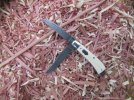Kerry, Ken and Brent, others: I have been cutting scales from rolls a lot lately and have now cut about 1,000 rolls and a few tapers into scales this past year. In the past a man would cut several rolls into scales and he might get 1,2,3 or very rarely 4 scales, from a roll. Normally you get one. Now after cutting several hundred scales form a hundred rolls you must match as best as possible. This is not easy by any means. You have to match for texture, match for width and length, and then try to determine the interior color.....from bright white to a dark tan. At times I just about give up and cannot match any. Well...this will not work as these scales must be matched up as best as possible or all the $$ is down the drain. To make matters worse no more stag is coming from India for a long while....thus the reason for the high pricing currently and for the forseeable future. The Sheffield cutlers tried to match also but if you look at many old knives the stag does not match at all. They had the same problems as we do. They also colored the stag with different agents...potassium permanganate being the most popular. Dyes and stains were a close second in Sheffield. Often they also used shellac over the coloring to set it. PP was most always used here in the states as the material was delivered with a spray of PP on all the stag to act as critter control. It also colored the stag a deep brown or black. American cutlers and their buying public came to accept this as the real color of stag. Every piece takes the PP differently. If you simply cleaned the stag you would have an off white or light tan material. Dark brown or black is caused by both dirt and the PP. The velvet or moss that grows on most all antlers, whether Sambar, whitetail, mule, chittal, etc. also has to be cleaned off of about 1/3 of all stag. This amount of velvet depends upon the season and the amount of activity for the stag. The farmers harvested the antlers .....but more accurately the found the drops and collected them at a centralized collection center. There was then a distribution center also. Collection and distribution is now outlawed in India. Sambar know no political boundaries so there still is a bit coming from China and elsewhere. Very limited however. My favorite part of knifemaking is the fitting of handle material. Kerry put it very well..it is an art and I have not done very well yet....not too artsy I guess.


